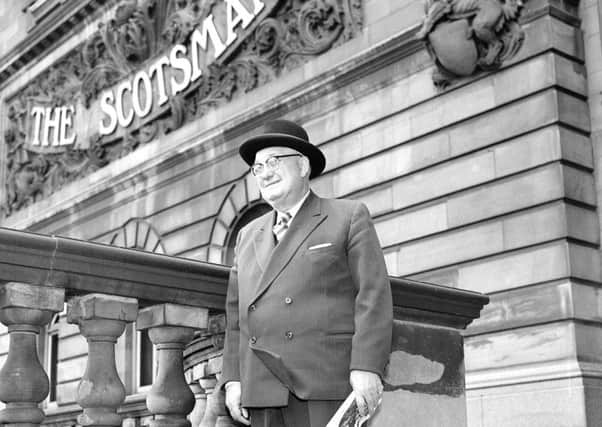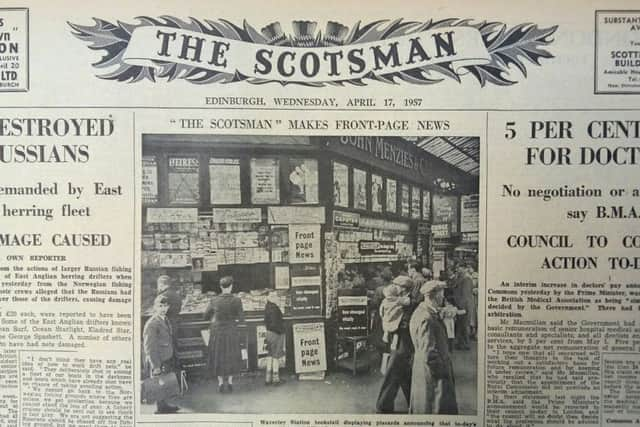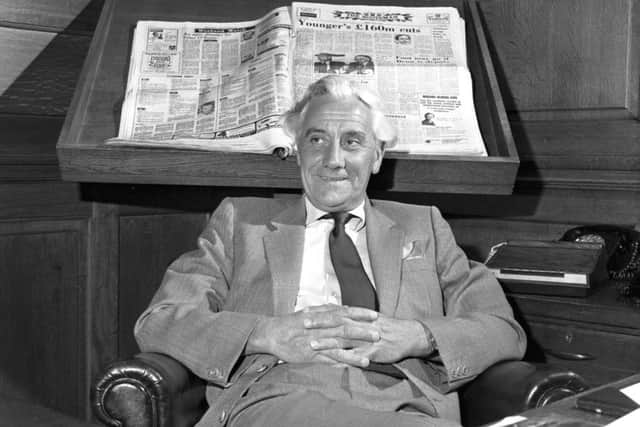Scotsman 200: Evolution of Scotland's national newspaper


The inky trade of journalism was a little different back in 1828, when The Scotsman was only 11 years old and the idea of capturing the most pertinent facts in a gripping first sentence was as alien as a modern laptop to those who reported with paper, quill and ink pot. For anyone hunched over an ale or a glass of claret in a public house on the Royal Mile it would have taken rather a long time to discover the fate of William Burke by reading the latest edition of The Scotsman. Only after labouring through almost 12,000 words would they have discovered the guilt of the infamous “resurrection man” in the final paragraph. Yet even then the editors were aware of the sales potential of a gruesome murder trial, which helped to boost sales of the young publication, as did its subsequent breathless account of the hanging of the “colossus of crime”.
Yet The Scotsman could never be described as a penny dreadful purveyor of “if it bleeds, it leads” journalism, instead favouring literary criticism, accounts of scientific expeditions, (it was the first publication to report on the existence of an ice age) and technological wonders. For was it not a Scotsman reporter who bravely strapped himself into the front seat on the first steam coach trip from Leith to Cramond? Over the first few decades The Scotsman earned a reputation for speaking truth to power and shining a light on matters the Edinburgh establishment would prefer to remain in the dark. The city’s town council, described by Lord Cockburn as “omnipotent, corrupt, impenetrable” were quite startled when the paper had the temerity to publish accounts of their secret meetings.
Advertisement
Hide AdAdvertisement
Hide AdThe fearlessness of The Scotsman even extended to offending the prejudices of its own readers. As a stout defender of the “equal rights and privileges” of “men of all persuasions” it published an editorial in 1851 which condemned the Ecclesiastical Titles Bill forbidding Roman Catholic bishops from using their territorial titles and mocked what the paper considered were anti-Catholic bigots. Almost a third of readers briefly cancelled their subscriptions.


The readership of The Scotsman was erudite and its news pages would have an impact on literature. Arthur Conan Doyle was a loyal reader and it was while perusing reports of Afghanistan that he decided to make Dr Watson, the companion of his latest fictional creation, Sherlock Holmes, a wounded veteran of the conflict.
The abolition of newspaper stamp tax in 1850 allowed The Scotsman to become a daily and it flourished over the next few decades. The expansion of the railway prompted the newspaper to spend £1,000 on its own early morning train service, complete with Scotsman livery, which they used to deliver papers for sale in Glasgow. In 1860 The Weekly Scotsman was unveiled and proved exceedingly popular among the Scottish diaspora, continuing for over a century. In 1868 The Scotsman opened an office on Fleet Street in London and later installed a private telephone in the House of Commons – notably it did not bother to open a Glasgow office until four years later.
The Scotsman was always a pioneering newspaper, intent on utilising all means to hasten the news. Carrier pigeons carried copy back to the office, especially from sports grounds, leading to the apocryphal story of a sports writer overheard shouting at his disappearing bird, “Hibs 4, Hearts 3”, after a late goal on the final whistle. In 1867 it became the first paper to hire a telegraph cable for its exclusive use from the Electric Telegraph Company; while in 1928 it became the first newspaper in Britain to send pictures by telegraph from Europe.
The Scotsman viewed the empire as a civilising influence and was an early supporter of William Gladstone, but disagreed over home rule for Ireland, fearing it would spell the break-up of the United Kingdom. Yet in later decades it recognised the growth of a home rule movement for Scotland. As an editorial explained: “A spirit of self-conscious nationalism has begun to make itself manifest in Scotland… when that happens it is necessary for wise men to sit up and take notice.”


When Scotland was flooded with fake £1 notes in the 1920s the police apparently searched The Scotsman offices on a tip-off and discovered that the photography room was ankle-deep in discarded notes, photographic plates and the appropriate chemicals for forgery. However, as there was no supporting evidence this may be what a future editor described as a story “too good to check”.
In 1953 Scotsman Publications was rescued from financial peril by Roy Thomson, a Canadian millionaire of Scottish descent, who owned a chain of newspapers in Canada and the US and, despite being snubbed by Edinburgh society, was intent on investing in the paper’s fortunes. He once said: “My pride in The Scotsman is so smart that I would even forgo profit in order to see improvement in it.” Thomson endeared himself to staff by finally installing a lift in the nine storey offices at North Bridge, prohibited by the previous owners who felt it would encourage laziness.
With a financial wind in the paper’s sails, The Scotsman secured its most able captain, the editor Alastair Dunnett, a playwright, author and devoted West Highlander who was dynamic, friendly and encouraged journalists to aspire to the finest writing. He gave a copy of AJ Liebling’s The Sweet Science to a young Hugh McIlvanney and insisted that there could be high art in low sports. In a few years the New Statesman would describe The Scotsman as “now one of the best-written, best-produced, and, in many ways, most civilised newspapers in Britain.” Dunnett’s editorship also saw the introduction of a Saturday magazine, a first among British papers, a supplement of 12 pages focusing on arts and literature.
Advertisement
Hide AdAdvertisement
Hide AdIn 1972 the editor’s chair passed to Eric Mackay, one of the paper’s most popular editors, who steered the heartbroken staff through the disappointment of the 1979 devolution referendum before retiring in 1985. Over the previous 30 years The Scotsman had three editors; over the next 30 years it would have 13. And where previously tradition dictated each departing editor be captured for posterity in oils, journalists joked that a quick Instamatic was now more appropriate.


The editor’s chair was most swiftly spun by Andrew Neil, appointed as publisher by the Barclay brothers, who purchased the paper in 1995 and applied both fresh financial resources, new staff and an agenda that was often at odds with the politics of its readers. Over the next ten years The Scotsman moved out of the famous North Bridge offices to newly built premises at Holyrood, expanded online and, in 2003, moved from broadsheet to “compact” format. In 2005 the Barclay Brothers sold The Scotsman to Johnston Press, who in 2013 moved out of Barclay House to new premises at Orchard Brae, where today a new generation of reporters, columnists, editors and photographers continue a noble tradition of speaking truth to power, writing the stories the authorities don’t wish to read and chronicling the times in which we live.
For two centuries The Scotsman has walked in step with the nation, accompanying the country down through dark valleys then rising into sunny uplands, always on hand with encouragement, through both kind words and stern. As The Scotsman celebrates his 200th birthday today it behoves all who believe in a free, indigenous press and who have long enjoyed his conversation to wish this grand old man of Scottish letters many happy returns as he strides on into the future.
Stephen McGinty was a reporter, feature writer and columnist with The Scotsman from 2000-2014 and is the associate producer of the recent BBC documentary, The Paper Thistle: 200 Years Of The Scotsman.